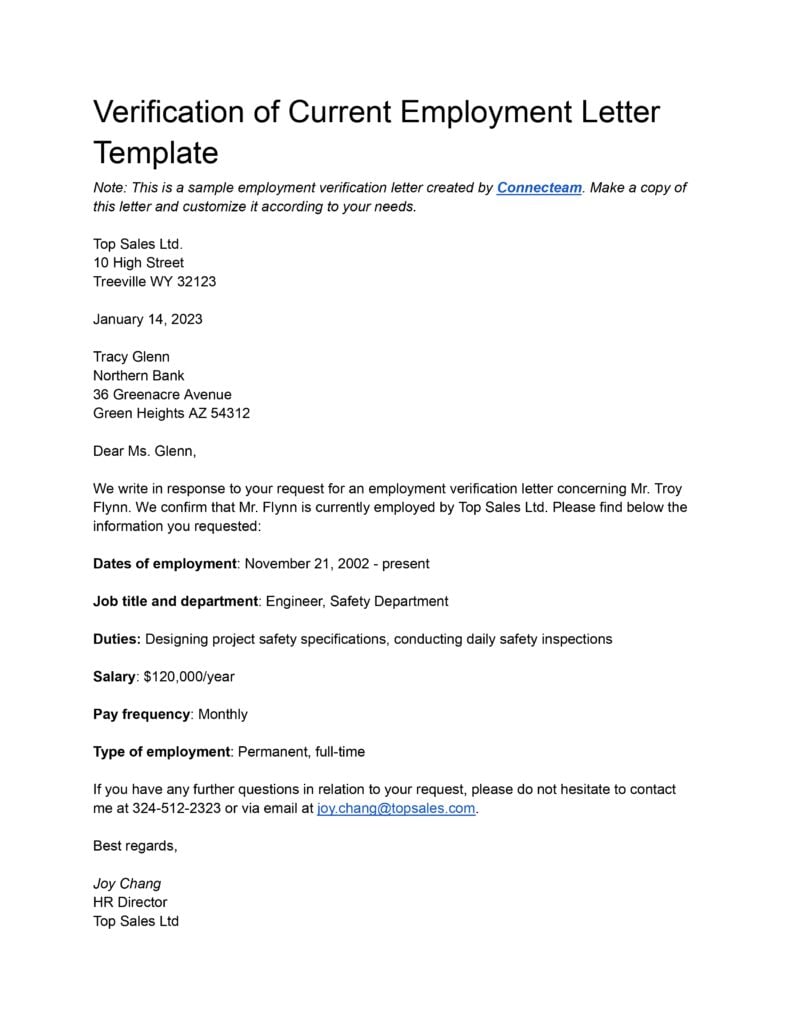When applying for a mortgage, lease, or another job, an employee or third party may ask you for a verification of employment letter. In this article, we explain what details you need to include in the letter and how to format it. Plus, we give you two easy-to-use templates to get started.
Key Takeaways
- Employment verification letters confirm someone’s employment status. They include information about their employment history, role, and salary.
- These letters are typically requested by financial institutions, landlords, other employers, or government agencies as proof of income.
- By having a relevant policy and procedure and using a template, you can produce these letters quickly and easily for your employees.
- Policies and procedures also ensure your letters are consistent and contain all the information relevant to the specific request.
As an employer, your employees may ask you to confirm details of their employment for mortgage lenders, landlords, or even another employer.
While employment verification letters are typically short and straightforward to prepare, it’s important to get them right.
Making a misstep not only reflects poorly on your company but can also affect an employee’s ability to get a loan, housing, or a new job.
In this guide, we step you through how to prepare a verification of employment letter, including what information to cover.
To help you out, we’ve also included some employment verification letter samples and prepared two ready-to-use templates.
Free Download: Your Employment Verification Letter ⤵
What Is an Employment Verification Letter?
A work verification letter is proof of someone’s current or previous employment. It confirms that an employee works—or worked—for your company and includes details like their dates of employment, role, and salary.
An employment verification letter is sometimes also referred to as a:
- letter of employment
- a proof of employment letter
- a work verification letter
- a salary verification letter
- a proof of income letter
- an employment verification form
These letters provide independent verification of key employment details for third parties. A request for a letter may come via an employee or directly from a third party, such as a bank, landlord, government agency, or other employer.
Work verification letters are different from reference letters or letters of recommendation that describe how well an employee performed in a role. Instead, proof of employment letters provide neutral information about an employee’s time with your company.
Where Do Employee Verification Letter Requests Come From?
Requests for a salary verification letter may come from an employee, who will then pass it on to the third party that requires the information.
Employees don’t have to tell you why they’re requesting the letter. However, they do need to tell you what information to include in it when they request a letter on behalf of a third party.
Requests can also come directly from third parties. These include:
- Financial institutions. For example, when an employee applies for a mortgage or other loan, the bank needs to confirm their ability to make repayments. If an employee applies to restructure an existing loan or defer payments due to financial hardship, the bank also often needs to confirm their income before deciding whether to grant their application.
- Landlords. When an employee applies to rent a property, the landlord may want to see that they have the ability to pay the rent, deposit, and other service fees.
- Other employers. If an employee submits a job application to another company, the prospective employer may want to request a work verification letter to cross-check the information in the employee’s resume.
- Immigration lawyers may request a letter from an employer when preparing a visa application for an employee or their family member. For example, a salary verification letter may be used as evidence of an employee’s ability to sponsor a family member’s permanent residency application.
- Debt collection agencies sometimes contact employers requesting work verification letters to encourage payment. You should seek legal advice about responding to these types of requests, as you can often only release limited information by law.
- Government agencies may request a verification of employment letter to identify instances of social security fraud or to confirm wages for a court decision. It’s best to speak to a lawyer for guidance if you receive a request like this.
It’s also important to seek legal advice to understand when you are required by law to respond to proof of employment letter requests.
Often you don’t have to do so. However, it can be a good idea to provide a letter if it supports an employee, for example, by helping them to get a mortgage, sign a lease, or find a new job.
Requests from government agencies are usually the exception to this. You may be required by law to respond to these and the request typically sets out the relevant regulation or law.
What Should Be Included in a Verification of Employment Letter?
There’s some basic information you should always include when writing an employment verification letter. Specific details depend on the request, as well as your company’s policy and the relevant laws and regulations.
Ensure your letter includes:
- The date the letter is written, so the recipient knows the information in it is current.
- Your company name and address.
- A greeting. If you know the recipient’s details, you can address them directly. If you don’t, use “To whom this may concern.”
- The employee’s full name.
- Their employment dates, including start and end dates. You can note the end date as “present” if the employee still works for your company.
- Your name and contact information, should the recipient have any questions or need further information.
- Your signature.
If specifically requested and allowed by law, you may also need to include:
- The recipient company’s name and address, if known.
- The employee’s job title and department.
- A brief description of the employee’s duties.
- The employee’s salary.
- Supporting evidence of their salary, like pay stubs or timesheets.
- Pay frequency—for example, weekly or monthly.
- The number of hours the employee works in a week or month.
- Their type of employment (full-time, part-time, or contract)
- Why their employment is ending.
- Whether their work is expected to continue.
- The employee’s eligibility for rehire.
Depending on the request, you can provide a verification of employment letter in digital or hard copy format and send it via post, email, or fax.
How to Format a Proof of Employment Letter
Prepare the letter on company letterhead or stationary with your company’s logo. This confirms its authenticity for the recipient.
The best way to present these letters is in business letter format.
Put your company name and address, the date, and the recipient’s address (if known) on the top left of the letter. Then, include your greeting, the content of your letter, and a formal sign-off, like “sincerely” or “best regards.” Your signature, name, and role should follow.
Work Verification Letter Policy and Procedure
As an employer, your employees may regularly request an employment verification form. For this reason, it’s useful to create a verification of employment letter policy and set out the procedure for requesting and preparing them.
Creating a policy and procedure ensures your company takes a consistent approach to proof of employment letters.
Policies and procedures also save you and your employees time. You can add them to your policies and procedures manual for your employees to easily find. By clearly setting out the steps, you get all the information you need from the employee without having to go back and forth.
Policy
An employee verification form policy sets out how requests for letters are dealt with and who is responsible for preparing them.
Before writing your policy, it’s important to confirm your legal obligations at both the federal and state levels. Verification of employment letters involves the release of sensitive employee information to third parties.
There are often laws and regulations around what employee information you can and can’t release and the process for doing so. For example, in some US states, employers can’t share salary history with third parties.
You may need to obtain signed consent from the employee to release their information before providing a proof of employment letter. It’s also a good idea to require requests in writing. Written requests and signed release forms create a record in the event of any later disputes—for example if an employee objects to the information you disclosed.
For these reasons, Human Resources (HR) is often tasked with responding to requests for employee verification letters. They can then ensure the letter complies with the company’s internal policy and any relevant laws.
Managers or supervisors can also prepare employee verification forms. However, HR should still review them before they’re sent.
Procedure
Creating a standard procedure for requesting verification of employment letters saves you and your employees time. Employees know who to make the request to and what information is required.
In your procedure, explain:
- Who employees and third parties should make the request to.
- Who’s responsible for preparing the letters.
- What information is needed to prepare the letter.
- Whether a digital or hard copy letter is required and where to send it.
- The timeframes for responding to requests.
- Links to any related policies or forms.
It may be useful to create a sample form that employees can use to request a letter. Adding the form to your policies and procedures manual or employee handbook makes it easy for your workers to find it. They simply fill in the required information and send it to the relevant person or department.
Pro tip: Use a dedicated HR document management system like Connecteam to easily manage all important employee documents and information.
Tips for Preparing a Work Verification Letter
When writing a salary verification letter, keep these points in mind.
Keep it short and to the point
These letters don’t need to be lengthy or complicated. They simply need to present the requested information neutrally. These letters shouldn’t go into opinions—for example, about an employee’s performance or character.
Proofread your letter before sending it
Like any external communication, a proof of employment letter is a reflection of your business. It should be error-free and professional.
Also, check that the letter contains all the requested information. It’s an important document for an employee that helps them get a mortgage, housing, or future employment. Providing incomplete information may slow down their application.
Ensure the information contained in the letter is accurate and truthful
The details in your letter should be based on HR records. Third parties may use your letter to make serious decisions concerning your employee, such as granting or denying a visa to an employee’s family member.
Accuracy also helps protect you against any later complaints from employees who are unhappy with the information you provided.
Provide the letter on time
Employee verification letter requests are often time-sensitive. For example, a bank considering a mortgage application may require the information within two business days.
If an employee has requested an employment confirmation letter, you should try to respond to them as quickly as possible. You can outline the turnaround time in your policy and procedure. Employees then understand how far in advance they need to make their requests.
Employment Verification Letter Samples
Below are two examples of work verification letters for both current and former employees.
Current employee

This verification of current employment letter template is formatted like a formal business letter. Customize the text to match your relevant information. Save a copy for your reference and keep your future employment verification correspondence quick, clear, and concise.
Free Download: Verification of Current Employment Letter Template ⤵
Former employee
This verification of past employment letter template is formatted like a formal business letter. Customize the text to match your relevant information. Save a copy for your reference and keep your future employment verification correspondence quick, clear, and concise.
Free Download: Verification of Past Employment Letter Template ⤵
Simplify the Process
Your employees may regularly need employee verification forms, so it’s useful to have a policy and procedure in place to handle their requests. This standardizes the process, helping you to provide letters in a timely way. It also ensures you include the necessary information like the employee’s role, job description, and salary.
By writing professional and accurate employment verification forms, you can help support your workers in buying their own houses, renting accommodation, and finding future employment.
Follow our step-by-step guide and use our employment verification letter templates to easily produce professional proof of employment letters on demand.




